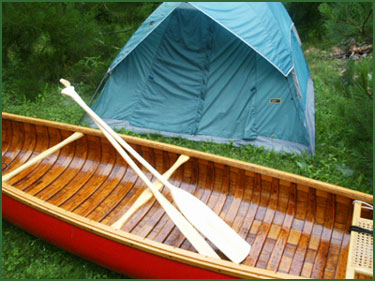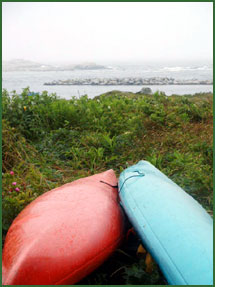Walking on Water:
The Nova Scotia Coastal Trail
By Rosemary Drisdelle

Nova Scotia's coastal communities have been hit hard economically by the ecological collapse of the fisheries. But an eco-tourism 'water trail' is helping to preserve nature while creating jobs.
On this typical summer morning, the coves and inlets along Nova Scotia's South Shore lie concealed beneath a blanket of fog. In the peaceful isolation found offshore, small waves stir the surface. At intervals, the quiet is disturbed by a gull's sharp protest or by the soft splash of a cormorant diving for fish.
The thick fog hides a beautiful and fragile coastline. Like many marine ecosystems around the world, it is under threat from human activity. But here, economic need, a new awareness of the environment and an ageless love of the ocean have come together to create a pearl of eco-tourism.
The Nova Scotia Coastal Water Trail unites boaters and maritime communities under a common cause - the protection and preservation of the coast - while creating local employment.
The shoreline here varies from the exposed and windswept granite of Peggy's Cove to the tree-covered shores of St. Margaret's Bay and Mahone Bay, sheltered inlets home to small communities, houses and cottages. Here too, tucked between stretches of rock like buoys strung along a net, are beautiful cobble, shingle and sand beaches.
On a perfect day, the sun and the breeze unite to push the fog off the coast. Clusters of small drumlin islands decorate the expanse of blue-grey water. These islands defend the inshore waters from the larger swells and waves of the open Atlantic, creating a zone of relative calm.
Marine life flourishes here. Seabirds fill the air and whales can sometimes be seen surfacing when waters are calm. In fine weather, the gentle waves near the shore become an ocean playground for another marine mammal, the recreational boater.
It is the water that draws many of us, the simple pleasures of wind and waves and the smell of the sea. But finding a site to launch, and more importantly, a place to come ashore, can be a challenge. It has been estimated that up to 95 percent of Nova Scotia's 7,500 kilometres of coastline is privately owned. Coastal land, including islands, is highly coveted, and much of it is being developed.
For those without access to the water's edge, the ability to cross the margin from land to sea is increasingly limited. To discover the invisible barricade, one has only to travel the land routes along the coastline to see roads framed with signs reading "Private Road," "No Trespassing" or "Turn Around Now."
Yet put-in spots for boaters is just part of the story. The use of shorelines by both recreational boaters and private landowners can harm fragile ecosystems. Coastal communities, economically ravaged by the ecological collapse of the fisheries, can do further damage if illegal poaching and destructive harvesting of natural resources replaces lost income.
These challenges led kayak enthusiast Sue Browne and a small group of friends in 1997 to envision a 'water trail' - essentially a hiking path on the sea. The idea is old rather than new. From the start of the first permanent settlements, homes and communities have grown up near water; before there were railways and roads, water trails connected people.
In Canada today, people and goods travel primarily by road, rail and air. Except for major routes like the St. Lawrence River, water trails are essentially recreational. They are "less concerned with livelihood," notes Browne, "but they're connected to livelihood because they're bringing people to coastal communities by a traditional way."
Water trails are again tracing the best routes along rivers, lakes and ocean coastlines all over North America, linking boaters with land access and community services. What's new is the level of environmental consciousness.
Nova Scotia's South Shore is a perfect place for a trail of this type. The Ecology Action Centre, an environmental group based in Halifax, took up the challenge, and in July of 2000 Sue Browne realized her dream as she joined a small fleet of boaters for the inaugural cruise on the sea trail. Subsequently, administration of the project was handed over to the Nova Scotia Coastal Water Trail Association.
The trail, still under development, hugs the shore from the UNESCO heritage town of Lunenburg to Nova Scotia's capital city of Halifax It is aimed at all types of recreational boats: kayaks, canoes, motorized boats, small sailboats and yachts. More than a playful line drawn upon the water, it is a real trail leading recreational boaters to safe harbour, scenic views and good picnic sites.
A guidebook provides sectional maps and descriptions of routes along the coast and points-of-interest on shore. An annotated map of a road on water, the guide identifies all the usual items: access points, businesses, scenic views, danger signs, places to stop, even beds for the night. These things make the trail a timely revival of an old tradition - boaters need to know where they can stop, where they can stay and where they can get help.
As intended, there are benefits for landlubbers too - boaters make use of services in coastal communities, boosting local businesses and benefiting the economy.
Economic spin-off is pivotal in ensuring the trail is successful as an eco-tourism venture, as local people discover that protecting the ecosystem can be more profitable than exploiting it in damaging ways.
 Sue Browne hopes the boaters on the trail embrace the same philosophy of ecological stewardship to ensure recreational waters and shorelines are preserved, a key feature of sea trails everywhere. "Water trails basically are a way of managing a resource, and that means that people who use them have to become involved in the concept, and adopt the ethic of the water trail which is conservation and low impact use."
Sue Browne hopes the boaters on the trail embrace the same philosophy of ecological stewardship to ensure recreational waters and shorelines are preserved, a key feature of sea trails everywhere. "Water trails basically are a way of managing a resource, and that means that people who use them have to become involved in the concept, and adopt the ethic of the water trail which is conservation and low impact use."
Low impact use includes camping in grassy areas away from delicate groundcover, building open fires below the high tide mark and packing away all garbage. Wildlife is not interfered with. Breeding and nesting areas are left undisturbed.
While mainland sites fall under these guidelines, islands are of extra concern and other water trail associations encourage members to volunteer as custodians to ensure that island sites remain pristine.
As the trail becomes more established, its guardians will have to be on the lookout for eco-tourism interlopers. Commercial profit seekers from outside, often with financial resources that dwarf those of local operations, are sure to move in, taking profits out of coastal communities and undermining trail benefits. Small seaside villages would become nothing more than rustic wallpaper for tourists to enjoy.
Benefits would also be weakened if businesses attract patrons by claiming to be ecologically friendly without the commitment. These opportunists wear the ecotourism hat but ultimately profit through over-exploitation. If an increase of boaters on the water is to protect the coast, the commitment must be real and lasting.
Browne wonders how many recreational boaters will be enough - or too many. "On one hand we've got this trail that is supposed to be attracting people [to help save it]. On the other hand we don't want too many people." It's a paradox that plagues any successful eco-tourism project. When the fine line of carrying capacity is crossed, environmental destruction begins anew.
There is already tension as to whether the trail is primarily about protecting nature or providing jobs. Critics argue that the concept of eco-tourism is a contradiction in itself: can people really use an environmental resource without changing it, sometimes profoundly? Reflecting on the value of the trail as wild space, Browne says, "the whole concept of maintaining areas that are wild is needed by all types of boaters. [They are] looking for a place to get away." She knows, though, that the more boaters use the trail, the less wild it will be. At some undefined point, it will cease to be a get-away and natural carrying capacity will be reached.
One way to lessen the impact of people on the trail is to make it longer. The shoreline from Lunenburg to Halifax is only a small section of the province's threatened coastline, and South Shore communities are not alone in the hardships suffered as a result of the fisheries crisis. The trail has lots of room to grow.
Indeed, Browne's original vision had the trail going all the way around Nova Scotia. One day it may move beyond its borders and link up with water trails in New Brunswick and the well-established Maine Island Trail.
However, it has been difficult to find funding to expand and monitor the trail, and to update the guide. Eco-tourists could be harming vulnerable ecosystems, and crown land sold to private interests could become inhospitable to boaters. The water trail association does not have paid staff.
Nevertheless, the trail will continue to grow in some form as seashore communities realize the aesthetic and economic value of coastal wild places, and see the potential of a water path to protect them. Under the guidance of the Nova Scotia Coastal Water Trail Association, community groups can begin to develop trail sections, each with a local focus and a local benefit.
Lower Prospect, for example, is home to East Coast Outfitters' Codfish to Kayaks program. Says ECO founder Dave Adler, "cultural and eco-tourism can provide a new cornerstone resource for coastal communities who can no longer depend on the fishery for survival."
The dream is that one by one the pieces will join together, until the trail traces all of Nova Scotia's coastline. Hopefully, this will form a continuous barricade of its own, one that protects and preserves the coast.
Skeptics may ask whether the trail is really for the environment or for the people. If this tourism initiative is to work it has to be for both. But at least the future of the water trail, and some of Nova Scotia's beautiful coastline, is where it should be - in the hands of people who know how fragile and precious it is.
Rosemary Drisdelle is a freelance writer living in Bedford, Nova Scotia
Written August 2003.
| Return to Top
|
| Articles Archive
| About Our Times |